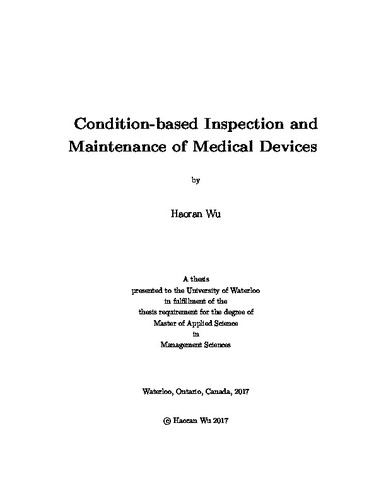| dc.description.abstract | Inspection and Maintenance of medical devices are essential for modern health services,
but the low availability of devices or unnecessary maintenance can cause major problems. A
proper maintenance program can signi cantly reduce operational costs and increase device
availability. For any maintenance program, two questions arise: 1) What kinds of devices
should be included? and 2) How and when should they be inspected and maintained? This
thesis proposes methods to solve those two problems.
For the rst question, numerous classi cation and prioritization models have been suggested
to evaluate medical devices, but most are empirical scoring systems, which can not
be widely used. To build a generalized scoring system, we propose a risk level classi cation
model. More speci cally, we select three important risk factors (Equipment function, Location
of use and Frequency of use), then use provided data to nd the relationship between
risk factors and risk levels. Four di erent classi cation models (Linear regression, Logistic
regression, Classi cation tree and Random forest) are used to analyze the problem, and all
of them are effective.
For the second question, some inspection and maintenance models have been developed
and widely used to assure the performance of medical devices. However, those models are
restricted to a few speci c kind of problems. In contrast, our model provides a more
comprehensive response to current maintenance problems in the healthcare industry, by
introducing a condition-based multi-component inspection and maintenance model. We
rst present a parameter estimation method to predict the deterioration rate of a system.
We use provided data and expectation-maximization algorithm to estimate the transition
matrix of system conditions. Then, we use Markov decision processes to solve the decision
model, which consists of two decisions: the next inspection time and whether to repair
the devices. The inspection interval is non-periodic in our model, and this flexibility of
non-periodic inspection model can avoid unnecessary inspections. We use relative value
iteration to nd the optimal inspection and maintenance strategies and the long-run average
cost. Changing the parameter of cost and the structure of the system clarified the
influence of these parameters. Our model achieves lower minimal average costs for complex
systems than previous periodic inspection models. | en |

